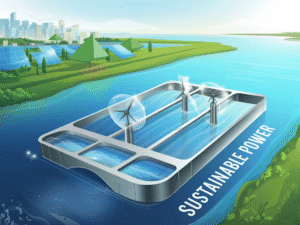Can saltwater and freshwater really generate electricity? The answer is yes—and it could change the future of clean energy forever.

We’re entering a new age where nature’s quietest collisions—like the meeting of river and sea—could power our cities. Osmotic power, also known as blue energy, taps into the immense and underused potential of salinity differences in water to generate clean, reliable electricity. And now, with nations like Norway and the Netherlands leading the charge, the world is watching this renewable innovation with fresh excitement.
Unlike solar or wind, which depend on weather, osmotic power flows 24/7, offering what energy experts dream of: consistency. But is it scalable? Can it compete with solar by 2030? And what’s holding it back?
Let’s explore the revolutionary potential of harvesting energy from salt water.
How Osmotic Power Plants Work: Inside Blue Energy Technology
Osmotic power is generated where freshwater rivers meet salty oceans—a natural salinity gradient that, when harnessed correctly, creates usable energy.
The two main technologies are:
- Pressure-Retarded Osmosis (PRO): Freshwater pushes through a semi-permeable membrane into saltwater. This increase in pressure spins a turbine to generate electricity.
- Reverse Electrodialysis (RED): Uses specially designed membranes to channel positive and negative ions, creating an electric current.
Both systems rely on advanced membranes and stable water sources, typically at river deltas, estuaries, or coastal plants.
Norway and Netherlands: The Global Leaders in Osmotic Power
Norway launched the world’s first osmotic power plant prototype in Tofte, capable of producing up to 10 kW with next-gen membranes. Though small, it proved the concept.
Meanwhile, the Netherlands is working on a more scalable version, using reverse electrodialysis with real-time river and sea water to test long-term viability. Their pilot facility at the Afsluitdijk has achieved promising performance metrics and aims to expand.
These two countries have created the blueprint for others to follow, showing how blue energy can fit into modern grids with existing renewable infrastructure.
Blue Energy Potential: Powering Coastal Cities from River-Sea Boundaries
It’s estimated that osmotic power could deliver 1,600–1,700 terawatt-hours per year globally—comparable to 50% of the EU’s current electricity use. That’s more than enough to power major coastal cities like New York, Tokyo, or Mumbai.
Because it operates continuously, osmotic power is a reliable base-load energy source, perfect for urban zones with:
- Access to both river and ocean water
- Infrastructure ready for renewables
- Pressure to decarbonize without compromising stability
For regions with dense populations and coastal geography, this is a game changer.
Membrane Efficiency: The Breakthrough That Changes Everything
The biggest barrier holding osmotic energy back? Membrane efficiency and cost.
Until recently, membranes in PRO systems averaged just 1–3 W/m², far below commercial needs (~5 W/m²). But recent breakthroughs are flipping the equation:
- Graphene oxide membranes now reach over 10 W/m² in lab settings.
- Nano-engineered thin-film membranes improve water flux and resist fouling.
- Bio-polymer and plant-based membranes drastically cut costs, making large-scale deployment affordable.
These advances mean osmotic power is finally entering the serious renewable conversation.
Can Osmotic Power Compete with Solar by 2030?
Right now, solar dominates the renewable energy landscape—but it also depends on daylight and storage solutions. Osmotic power offers something solar can’t: round-the-clock consistency.
Market projections suggest that by 2030, osmotic power could:
- Replace diesel generators in remote coastal areas
- Supplement solar and wind in hybrid grids
- Reach cost parity in specific regions with abundant water access
It’s unlikely to replace solar globally, but in the right environments, osmotic power will be a major piece of the clean energy puzzle.
FAQ Section
Q: What is osmotic power and how is it generated?
A: Osmotic power is created from the natural salinity difference between freshwater and saltwater. Using specialized membranes, it transforms this gradient into usable energy through either pressure (PRO) or ion flow (RED).
Q: Which countries are leading the way in osmotic power?
A: Norway and the Netherlands have conducted the most advanced real-world pilot projects, demonstrating the viability of osmotic power in both small-scale and scalable models.
Q: What are the advantages of osmotic energy compared to solar?
A: Osmotic power is constant, doesn’t rely on sunlight, and works in any weather. It can provide stable electricity at night and during storms, complementing solar and wind.
Q: Why isn’t osmotic power widely used yet?
A: Until now, membrane materials were too expensive or inefficient for widespread deployment. But new breakthroughs are pushing osmotic energy into a commercially viable space.
Q: Can osmotic power really power entire cities?
A: Yes, especially coastal cities with large rivers nearby. It’s not likely to replace all sources, but it can significantly reduce fossil fuel dependence and stabilize renewable grids.

